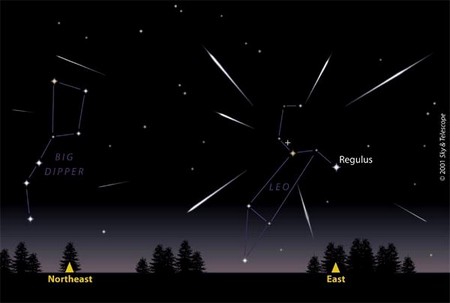3
2009
Who Discovered Constellation Leo
Constellation Leo is very easy to spot in the night sky. In spring it takes up much space in the northern hemisphere. In autumn Leo runs to the southern hemisphere. Leo is the fifth zodiac sign, but is the most visible of all.
How do you know you are looking at Leo? You are supposed to see a crouching lion that looks to the west. You should see the head and mane clearly, above which hangs a sickle of stars. If the sickle is not sharp enough, you should see an inverted question mark at least.
Leo’s brightest star is Regulus. It is found south of the pointy stars of the Big Dipper, northwest of Virgo. Leo shines brightest on or around March 1.

Leo in ancient Egypt
The figure of a lion has been associated with the sun since the earliest times. Belief in the lion as symbol of the sun began in ancient Persia. More than 5000 years ago, the sun “passed over” Persia and Egypt at the height of the midsummer solstice. From then on Leo was lumped in with the coming of high summer. Leo’s time was poetically called “the realm of the sun”. On closer inspection, you cannot miss the Sphinx’s body, which is that of a lion.
Even in ancient Africa, the lion stood for strength and power. It is no king of the beasts for nothing.
Leo in the story of Pyramus and Thisbe
According to Roman mythology, Leo was the symbol of the Nemean lion, one of Hercules’s greatest fights. Hercules was tasked to skin a gigantic lion whose hide did not even bruise against metal and stone. Being a demigod, Hercules managed to pin down the lion with his bare hands. He choked the lion to death and skinned it with the use of its own claws. The hero took home the hide as his trophy, but not without turning it into an invincible cloak. The lion’s head he made into a helmet.
To the ancient Greeks, the Leo figured in the love story of Pyramus and Thisbe. Ovid’s Metamorphosis recounts of how Pyramus and Thisbe’s parents objected to their romance. Sounds like Romeo and Juliet? It must have been one of the ancient sources. What the two-star-crossed lovers did was talk through a tiny hole in the wall that divided their houses. One day they hatched a plan to meet far outside the city. It had to be right next to a mulberry tree. When the day came, Thisbe came all by herself. Pyramus was nowhere in sight. She waited for some time and soon enough a lion fresh from a kill strayed by.

Thisbe ran for her life. She was just quick enough to get her body out of the lion’s way. Instead the lion snapped and pawed at a piece of her veil. Pyramus arrived late to see Thisbe’s veil in bloody pieces. He instantly thought Thisbe was mauled dead by the lion. He pulled his sword and drove it deep into his body. Pyramus did not think twice to kill himself to be with his love. Thisbe came back and saw her dead Pyramus. She threw herself on Pyramus, cried hard, and thrust the bloodied sword into her body. The lovers’ blood soaked into the white mulberry flowers. And the deep red color stayed ever since. The supreme god Zeus hung Thisbe’s veil up in the sky, with the lion just above it. The veil was later known as Coma Berencies.
Leo in ancient Middle East
Leo’s moon, Regulus, got its name from Copernicus. The name originally meant “the little king.” The ancient Sumerians called Regulus as the “star of the king.” In ancient Persia and Iraq, Regulus was called “the flame” or “red fire.” They associated red fire with the onset of an extremely hot summer. Ancient Persians considered Regulus one of the four royal stars: The other royal stars were Fomalhaut, Aldebaran, and Antares.
By 2300 BC ancient astronomers in the Middle East had observed that the sun moved in near Regulus. As it did, the summer grew hotter and hotter. The ancients gave this role to Sirius at a later time.
Meanwhile, the stars of Leo formed a horse in ancient Chinese zodiac.
Leo’s stars
Two of leo’s famous stars are Algiebra and Wolf 359. Algivebra is abinary system (meaning a pair). The brighter one looks like giant orange, right next to a giant ripe lemon (the smaller pair).
Wolf 359, on the other hand, the least visible of Leo’s stars, in spite of being popular. It was discovered by Max Wolf in 1918.

 An article by
An article by 




